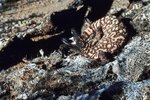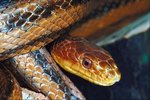
Copperheads are highly adaptable snakes who thrive in a variety of habitats, including forests, wetlands, riparian zones and suburban areas. Herpetologists formally recognize five subspecies of copperhead in the United States; they're found throughout the East and the South. While the different populations display unique characteristics and dietary preferences, all copperheads are generalist predators who will consume virtually any animal small enough to eat.
Copperhead Prey
Rodents are key prey for adult copperheads. Equipped with thermoreceptive pits on their face, copperheads are able to “see” warm-blooded rodents -- even in complete darkness. Copperheads primarily consume small rodents, such as deer mice (Peromyscus sp.), voles (Microtus sp.) and chipmunks (Tamias striatus). Adults also consume frogs, birds, lizards, caterpillars, cicadas and other snakes. Young copperheads primarily consume insects, snakes, lizards and small frogs. Young copperheads lure frogs into striking range by twitching their bright yellow tail tips.
References
Resources
- Copeia: Ontogenetic Changes in the Resistance of Bullfrogs (Rana catesbeiana) to the Venom of Copperheads (Agkistrodon contortrix contortrix) and Cottonmouths (Agkistrodon piscivorus piscivorus)
- Journal of Chemical Ecology; Venom Variation and Chemoreception of the Viperid Agkistrodon Contortrix: Evidence for Adaptation?
Photo Credits
-
Jupiterimages/Photos.com/Getty Images



